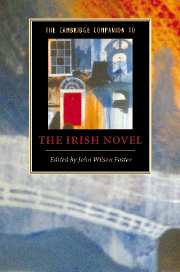Book contents
- Frontmatter
- Introduction
- 1 The novel before 1800
- 2 The national tale and allied genres, 1770s-1840s
- 3 The novel of the big house
- 4 The Gothic novel
- 5 Catholics and fiction during the Union, 1801-1922
- 6 Irish modernisms, 1880-1930
- 7 James Joyce
- 8 Region, realism and reaction, 1922-1972
- 9 The novel in Irish
- 10 Women novelists, 1930s-1960s
- 11 Two post-modern novelists: Samuel Beckett and Flann O’Brien
- 12 Life writing in the twentieth century
- 13 The novel and the Northern Troubles
- 14 Contemporary Irish fiction
- Index
6 - Irish modernisms, 1880-1930
Published online by Cambridge University Press: 28 January 2007
- Frontmatter
- Introduction
- 1 The novel before 1800
- 2 The national tale and allied genres, 1770s-1840s
- 3 The novel of the big house
- 4 The Gothic novel
- 5 Catholics and fiction during the Union, 1801-1922
- 6 Irish modernisms, 1880-1930
- 7 James Joyce
- 8 Region, realism and reaction, 1922-1972
- 9 The novel in Irish
- 10 Women novelists, 1930s-1960s
- 11 Two post-modern novelists: Samuel Beckett and Flann O’Brien
- 12 Life writing in the twentieth century
- 13 The novel and the Northern Troubles
- 14 Contemporary Irish fiction
- Index
Summary
The un-Englishness of Modernism
'Modernism' does not just refer to the literature of a certain period of time, say 1890 or 1910-1940. The '-ism' suggests it was a distinctive doctrine, or at least a distinctive practice. Yet it is best not to attempt a strict definition of the typical modernist work. No two writers wrote to one formula (though Ezra Pound, an impresario of the modern, tried to get many to do just that). Modernist works deploy devices or manifest traits that include the following: (a) perspectivalism: knowledge limited to the point of view of specific persons (the most radical form being 'stream of consciousness'); (b) juxtapositions without copulas: the omission of transitional matter that would indicate grammatical, chronological or logical relationships; (c) presentation of images or events without commentary or explanation; (d) style of presentation so radically in service of subject matter that, paradoxically, style becomes the subject of attention; (e) parody of popular literary styles and, by implication, mockery of the general readership that made such styles popular; (f) learned allusions to literary classics; (g) mythic parallels to contemporary life and demythologising treatment of Christianity; (h) a governing principle of 'art for art's sake': self-conscious neglect of a utilitarian purpose for the work, such as to teach a moral or move the public to action; and (i) the manifestation of literary art in every sentence or line, as Joseph Conrad demanded of prose writers equally with poets.
- Type
- Chapter
- Information
- The Cambridge Companion to the Irish Novel , pp. 113 - 132Publisher: Cambridge University PressPrint publication year: 2006
- 5
- Cited by

